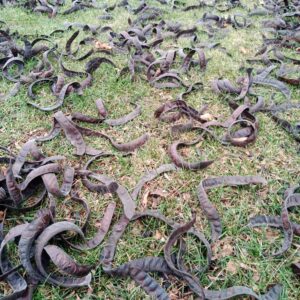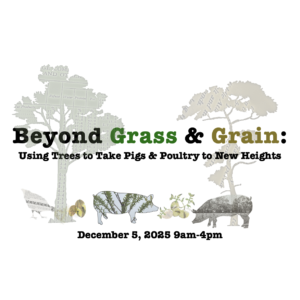Hey folks,
I wanted to share with you an update on where we’re at with honey locust propagation. We’ve hit a roadblock lately with propagation, so we’re making adjustments which will delay rollout of more honeys in the near future, and if you’ve been looking forward to getting improved honey locust seedlings, you’ll want to read this.
[Nerd-out warning: we get into some detail about genetics and breeding, so if you want to skip to the “what does this mean for me right now?” section, jump to the next-to-last paragraph.]
There is likely no tree with higher potential for use in silvopasture, and across a wider range of the United States than honey locust. They cast a dappled shade, fix nitrogen and have durable wood. And of course, they yield sweet, high-energy pods that drop during the winter, when additional feed energy is most needed.

There is one thing holding the tree back from fully living up to its enormous and widespread potential: thorns. Anyone who has ever dealt with wild, thorny honeys knows all too well what nasty thorns these trees can carry, able to puncture tractor tires and scare off even the most devoted of tree-huggers. The tree developed those thorns so it could stand up to heavy browse and rubbing, but they present a real liability for farms.
I have long recognized the great potential of honey locust. I happen to live only 25 minutes from one of the best collections of improved honey locust in the country, trees that were selected because of their ability to yield lots of pods of high sugar content. Those trees, all thornless and yielding tremendous crops of pods, 80 or so years after they were planted, are the embodiment of the tremendous potential of honey locust in silvopasture systems.
Recognizing the value of honeys, and the fact that there were hardly any improved varieties available for purchase, we set out to start growing improved varieties ourselves. The most cost-effective and most scalable way to start was through seedlings. We collected seed from those trees that yielded the biggest, sweetest pods, cleaned out the seed, and worked with nurseries to have those custom grown for us.

As of writing in December 2022, we recently started getting some feedback we weren’t expecting. As some of our selected seedlings are hitting 4-5’ tall, more and more are developing thorns, in some cases as high as 75% or more of the batch. That is much higher than we had anticipated. We had up until then seen about 25% develop thorns, which was higher than I’d like, but still acceptable. But those seedlings were only 2’ tall or so. And once planted out in the field and matured, more and more started to develop thorns, to a rate that was simply unacceptable for us to continue with.
To complicate the matter, it seems that some batches have been significantly less thorny than others, likely because of the parent trees they were grown from. Trouble is, we haven’t to-date kept batches from different trees strictly separated, so we can’t go back and isolate which trees yield thorny progeny at a higher rate than others. Because thorns seem to be primarily a genetic trait, certain trees will indeed pass on thorny or thornless traits at a higher rate. What complicates the matter for our selection purposes is two things: all the trees we collect from are thornless, and we don’t know which males are pollinating trees.
As I said above, all the trees we collect pods from are thornless, which would seem to mean that their offspring should also be thornless. But, while thornless on the outside, we can’t tell whether they are thornless on the inside. See, you can make a thornless honey locust tree from the most viciously thorny honey locust. Almost all honeys will stop developing thorns at a certain distance from the ground. Since no herbivores can reach 20’ in the air, it’s not worth the plant investing in thorns that high up. The height at which honeys stop developing thorns is highly variable, but they do stop developing thorns at some point. And if you want, you can get a cherry picker and take scion (pieces of wood for grafting) from that zone where no more thorns grow. Grafted trees grown from scion from thorny trees will be thornless, if that scion is taken from above the thorn line. Through this method one can make a thornless tree, even though the genetics it carries are to produce thorns.
As great of a trick as this might be, it has its downfall, namely that the seedlings produced from the tree, whether coming up in a pasture or in a nursery bed, will still be influenced by the thorny genetics of the ortet (the original tree from which a clone came). Because most of the trees at the grove we collect from are likely to be grafted, and graft scars are very difficult to detect on honeys, we have no good way of telling which of the thornless trees we are collecting seed from actually have the genetics for thornlessness, and which are simply grafted trees that originate from thorny trees.
In those few instances where we’ve identified a high quality wild tree that we know is a seedling, and that has no thorns, we would love to collect seed from it, but are hampered by the fact that they usually have thorny male trees around that would be contributing their undesirable genetics to the seed. We may still collect seed from them for trial purposes, but we’ll likely get a very high rate of thorny seedlings.

So with all this in mind, we’ve determined we need to pump the brakes on selling seedlings for now, and invest deeply in a propagation and breeding program that will yield trees that are consistently thornless (first priority) and have high sugar pods. They will also need to be inexpensive so as to be widely available. As you might imagine, that’s a fairly big lift, and not something that happens overnight, given that we’re talking trees and they take their good old time to grow.
We’ll be going about this in a number of different ways, including through grafting, propagation via root cuttings, and breeding for improved seedlings. Other means, like tissue culture, will be explored as well.
Grafting: We will continue to expand our production of grafted honey locust trees. We have our first small batch of grafted trees to work with in Spring ’23, which we’ll be using on our own internal projects. Then we anticipate having 5,000+ grafted honeys for Spring ’24, again mostly for internal projects. Our production of those trees will continue to grow over time, as our availability of scion increases, and the demand increases for these grafted trees. Production of grafted trees, especially from selections that are known to be genetically thornless, is a proven, scalable way forward.
Root cuttings: One of the ways honeys can be propagated is via root cuttings, which similar to grafting yields an exact clone of the tree. In the long run it looks like this will be the most economical path, since it’s low-tech and pretty labor efficient. What is going to slow us down is that we only have access to so many quality trees with young enough root systems that are vigorous enough to regrow from root cuttings. This is a propagation method that will necessarily have to start small, and grow with every season as we’re able to multiply roots. It’s most likely that we won’t even be able to sell any of these resulting trees for the first 2-3 years while we build up a larger base from which to propagate.
Seedlings: We will temporarily be halting the sale of our seedlings, unfortunately. With the high rates of thorns that we are seeing, we just cannot in good conscience sell these with the knowledge that they will likely cause problems for many. Instead, what we will be doing is starting a breeding program, from which we intend to grow consistently thornless and high sugar yielding seedling trees in the future. To do that, we are going to be culling any and every thorny honey locust we grew from seed. Those remaining thornless trees will be grown out to be 5’ tall and over, so we can determine whether they bear thorns as they mature. All that pass the test will then form the basis of a long-term seedling breeding program, and also be available to propagate via root cuttings or grafting.
As you can tell, we’re talking about work that will happen over the course of quite a few years. At this point we likely won’t have honey locust trees for sale outside of our own projects for at least 2 years, if not more. However, that doesn’t mean you need to put silvopasture on hold entirely. This actually fits in very well with a strategy we advise to many of our clients, namely to start with planting fast growing and easy trees, like black locust and hybrid poplars and willows, and only later, in phase 2+ of planting, establish more of the longer-term trees like honeys, persimmons, oaks, hickories, pears, etc. Focusing on fast-growing trees first, you can cut your teeth on easier trees, and get the quickest return on investment by getting shade in under 5 years. Those trees are also cheaper to establish, which is nice since at this early stage in the game, there isn’t a ton of financial support for silvopasture in many regions. That support will grow in the years ahead, at which point you’ll have access to more cost-share for those trees where genetics are more important. And because better silvopasture-specific genetics of a whole bunch of trees, not just honey locust, will be coming out in the years to come, this approach gives time for those better genetics to be available.
We were frustrated to hit this roadblock in the propagation of honey locust, given the high potential the tree shows for use in silvopasture. But thankfully we have identified some very solid paths forward to making real improvements to the tree, so that in the long term we will see honey locusts attain their full potential as a thornless, high energy pasture tree, delivering shade and stockpiled feed to farms from Maine to Georgia, and Texas to North Dakota.




